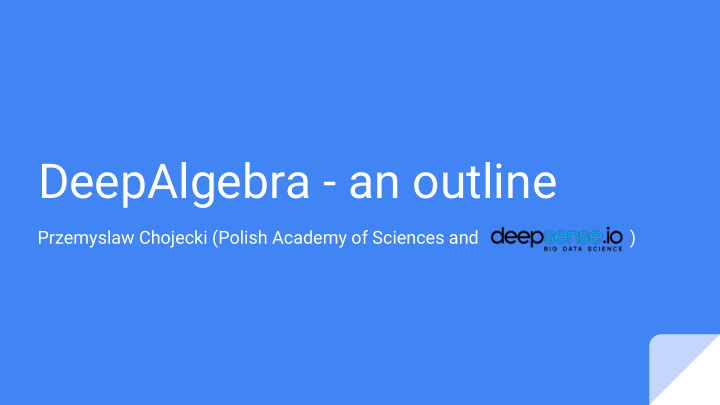



DeepAlgebra - an outline Przemyslaw Chojecki (Polish Academy of Sciences and )
Problems within mathematics Growing number of mathematical research (--> arXiv). More complicated, more interdependent. Impossible to verify correctness for “outsiders” - knowledge is accepted as knowledge by a small group of experts (e.g. problem with accepting Mochizuki’s proof of abc-conjecture; not understandable to other experts).
Problems within mathematics
Potential solution Automation or semi-automation of: ● Producing mathematics ● Verifying already existing mathematics
Automatic theorem proving Current approach to automatic theorem proving: - Take a mathematical work (e.g. Feit-Thompson theorem or proof of Kepler conjecture) - Rewrite it in Coq/Mizar/other Interactive Theorem Prover - Verify! References: T. Hales, ”Developments in Formal Proofs”, Seminaire Bourbaki 1086. abs/1408.6474.
Drawbacks 1. Mathematical work is based on previous works. One needs to lay down foundation each time at least to some extent (but e.g. Mizar Math Library). 2. Tedious work of filling in gaps (human way of writing mathematics is different than what Coq/Mizar accepts). 3. Purely manual work!
Outcome Once in Coq/Mizar, there are growing number of methods to prove new theorems: -> hammers -> tactics -> machine/deep learning (?) References: J. Blanchette, C. Kaliszyk, L. Paulson and J. Urban, ”Hammering towards QED”, J. Formalized Reasoning 9(1), pp. 101-148, doi:10.6092/issn.1972-5787/4593. A. Alemi, F. Chollet, G. Irving, C. Szegedy, J. Urban, ”DeepMath - Deep Sequence Models for Premise Selection”, arXiv:1606.04442
Towards automation To fully use power of machine/deep learning, one needs more data! Moreover in order to stay with current research we need to translate LaTeX -> Coq/Mizar much faster! Need: automate translation of human-written math LaTeX work to Coq/Mizar.
NLP problem Human-written LaTeX math file Coq/Mizar View it as an NLP problem of creating a dictionary between two languages. References: M. Ganesalingam “The Language of Mathematics”, LNCS 7805
Building a dictionary Enhance usual syntactic parsers (e.g. TensorFlow's SyntaxNet) with Types and variables. “Let $G$ be a group” ---> “G” is a variable of Type “group”. Use it to translate LaTeX into Coq/Mizar sentence by sentence. Still need a good source of mathematics!
Algebraic geometry One of the pillars of modern mathematical research, quickly developing, but having a good foundation (Grothendieck’s EGA/SGA, The Stacks Project). “Abstract” hence easier to verify for computers than analytical parts of mathematics.
The Stacks Project Open multi-collaboration on foundations of algebraic geometry starting from scratch (category theory/algebra). Well-organized structure (easy-to-manage dependency graph). Verified thoroughly for correctness.
The Stacks Project The Stacks Project now consists of 547156 lines of code ● API to query ! 16738 tags (57 inactive tags) ● ● 2691 sections ● 99 chapters - Statements (LaTeX) - Data for graphs 5712 pages ● 162 slogans ●
DeepAlgebra - an outline 1. Build a dictionary (syntactic parser with Types/variables) 2. Test it on the Stacks Project (build an “ontology” of algebraic geometry) 3. Verify, modify, test it on arXiv (Algebraic Geometry submissions)
Thank you for your attention!
Recommend
More recommend